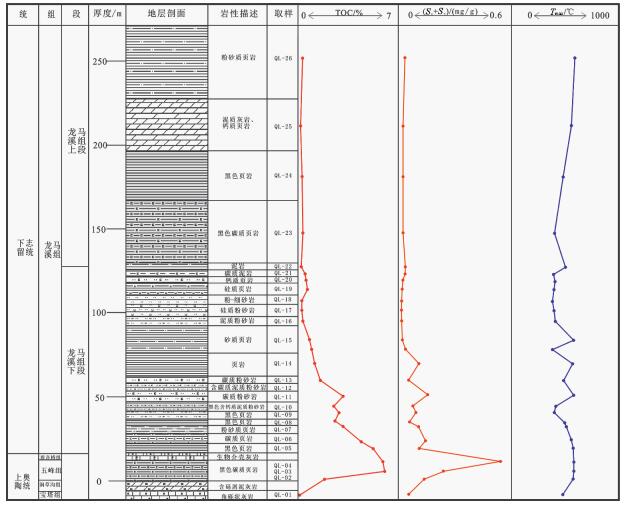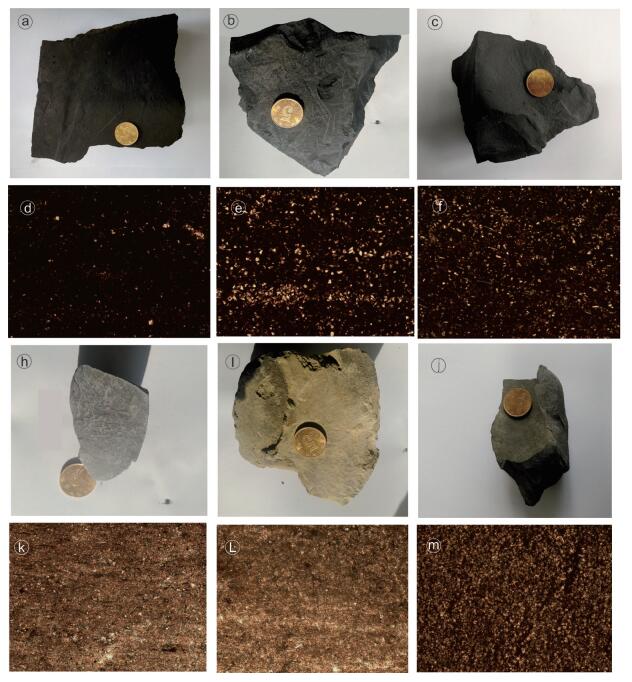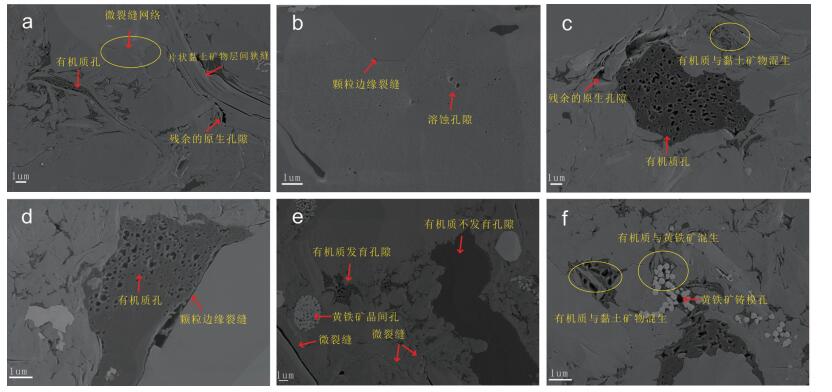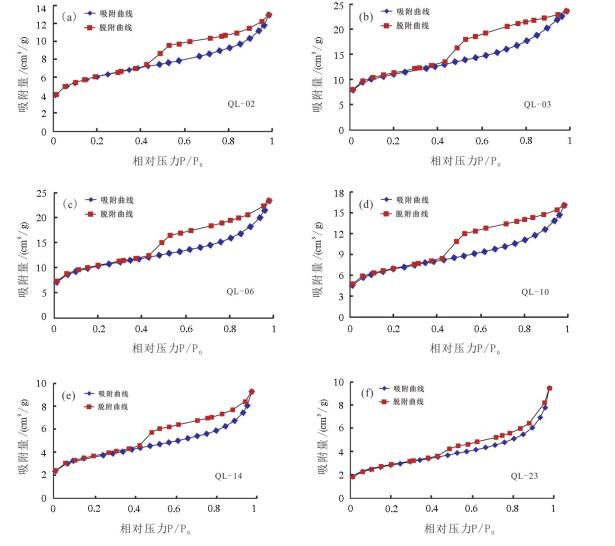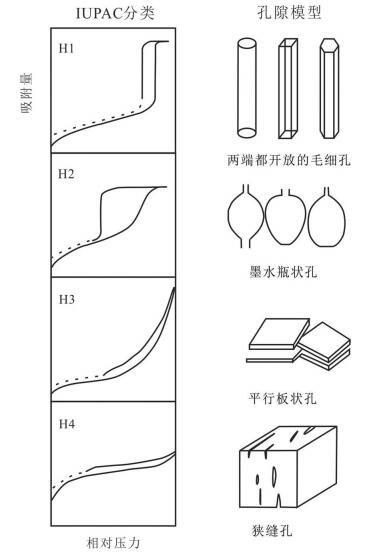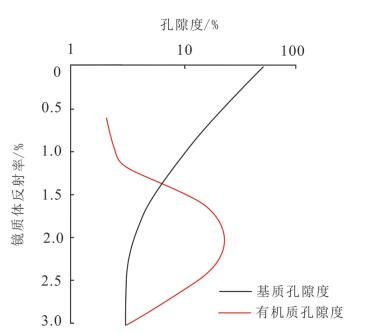Micropore structure characteristics of Wufeng-Longmaxi Formation black shale along Qilongcun section in northwest Guizhou
-
摘要:
页岩的孔隙类型、结构对于页岩气资源评价与开采具有重要意义,为了进一步认识页岩孔隙结构特征及其演化规律,利用场发射扫描电镜、氮气吸附实验对黔西北骑龙村剖面五峰-龙马溪组黑色页岩微观孔隙类型、结构进行了研究,结果表明,研究区五峰-龙马溪组页岩气储层的储集空间类型多样,主要包含粒内孔、粒间孔、有机质孔和微裂缝。页岩孔隙以介孔为主,介孔是页岩气的主要储集空间;孔隙结构以墨水瓶状孔和平行板状孔为主。探讨了影响页岩孔隙发育的主要因素,有机碳含量、热演化程度和矿物成分含量均对页岩孔隙的发育有影响,而且并非单相性的,是相互制约的。研究剖面石英含量与微孔、中孔的发育程度呈良好的正相关关系,而与宏孔发育程度的相关性不明显;黏土矿物含量与微孔、中孔的发育程度的相关性不明显,而与宏孔的发育程度呈负相关关系;有机质孔隙正处在其发育高峰期,对于页岩孔隙具有重要贡献,且随成熟度增加而增加。
Abstract:Pore types and structures are of great significance for shale gas resources evaluation. In order to study the pore structure features and evolution regularity of shale, the authors used field emission-scanning electron microscopy (FE-SEM) and nitrogen adsorption method to study the pore characteristics and structures of black shale samples from the Late Ordovician-Lower Silurian Wufeng-Longmaxi Formation of the marine shale gas reservoir in northwest Guizhou. The results show that the shale has various kinds of reservoir space, mainly comprising intragranular pores, intergranular pores, organic pores and microfractures. Low temperature nitrogen adsorption experiment results show that the pores in the shale are mainly mesopores in size, and mainly include ink bottle-like and parallel plate-like pores in structure. The authors investigated the main factors influencing the shale pore development, organic carbon content, degree of thermal evolution and content of mineral composition and found that their actions were not conducted singly but restricted each other in influencing the development of shale pores. Quartz content is correlated positively with micro-and mesopores, but has no evident relationship with macropores. Clay content has no obvious relationship with micro-and mesopores, but has negative relationship with macropores. The organic matter pore is at its peak of development, has an important contribution to shale pores, and increases with the increase of maturity.
-
Keywords:
- shale /
- pore structure /
- northwest Guizhou /
- Longmaxi Formation
-
1. 引言
页岩作为一种特殊的天然气储层,具有低孔、低渗及非均质性的特点(陈乔等,2013;魏志红等,2012;韩双彪等,2013;Sun et al., 2016; Guo et al., 2014),其储集条件的优劣是影响页岩气富集的主要因素之一(王玉满等,2012)。页岩气在储层中主要以吸附气和游离气形式存在,吸附态气体主要赋存于泥页岩的微孔和介孔中,游离态气体则存在于泥页岩的宏孔和裂隙中(邹才能等,2010)。此外, 还有少量气体溶解于液态烃以及水中(王飞宇等,2011;魏祥峰等,2013)。页岩储层孔隙的结构和类型是决定页岩气的赋存形式、储集性能、运移能力等的重要因素,正确认识页岩的孔隙类型、结构对于评价与开采页岩气资源具有重要意义(赵迪斐等,2016)。
为了进一步认识研究区页岩孔隙结构特征及其演化规律,为页岩气资源评价提供基础数据、理论依据和参考资料,本文详细研究了黔西北骑龙村剖面上奥陶统五峰组—下志留统龙马溪组黑色页岩的储层孔隙类型及孔隙结构,并探讨了影响页岩储层孔隙发育的主要因素。
2. 样品与实验方法
2.1 样品采集
页岩样品采自贵州省遵义市习水县骑龙村的五峰—龙马溪组剖面。骑龙村剖面位于黔中隆起北部,在大地构造上位于上扬子板块,在沉积相上属于深水陆棚边缘(图 1),为出露比较完整的五峰—龙马溪组剖面;剖面厚265.28 m,分为上下两段,下段厚111.26 m,上段厚154.02 m;岩性包括黑色页岩、炭质页岩,局部夹粉砂质页岩(图 2),富含笔石化石,页理发育;具有一定的纵向渐变性,总体上具有向上颜色逐渐变浅, 有机碳含量逐渐减少,粉砂质和灰质含量逐渐增多的特征(图 3)。
![]() 图 1 骑龙村剖面地质概况a—为剖面地质简图据(杨迪等,2013修改);b—为研究区晚奥陶—早志留沉积相图(据 Guo Xusheng et al., 2014a)Figure 1. Geological map of Qilong sectiona-Brief geological profile of Qilong section, after Yang Di et al., 2013; b-Sedimentary facies of the study area during late Ordovician-early Silurian, after Guo Xusheng et al., 2014a
图 1 骑龙村剖面地质概况a—为剖面地质简图据(杨迪等,2013修改);b—为研究区晚奥陶—早志留沉积相图(据 Guo Xusheng et al., 2014a)Figure 1. Geological map of Qilong sectiona-Brief geological profile of Qilong section, after Yang Di et al., 2013; b-Sedimentary facies of the study area during late Ordovician-early Silurian, after Guo Xusheng et al., 2014a![]() 图 3 骑龙村五峰—龙马溪组页岩及其薄片照片a—QL-4黑色炭质页岩;b—QL-9黑色页岩,可见笔石化石;c—QL-10粉砂质页岩;d—QL-4黑色炭质页岩薄片(单偏光);e—QL-9黑色页岩薄片(单偏光);f—QL-10粉砂质页岩薄片(单偏光);h—QL-20钙质页岩;i—QL-22黄绿色泥页岩;j—QL-26粉砂质页岩;k—QL-20钙质页岩薄片(单偏光);l—QL-22黄绿色泥页岩薄片(单偏光);m—QL-26粉砂质页岩薄片(单偏光)Figure 3. A part of hand specimen and its microphotograph of Wufeng-Longmaxi shale in Qilongcun section Fig. a, b, c, h, i and j are part of hand specimens of Wufeng-Longmaxi Formation; Fig. d, e, f, k, l, and m are corresponding microscopic photographs of a, b, c, h, i, ja-QL-4 Black carbonaceous shale; b-QL-9 Black shale, graptolite is obvious in the specimen; c-QL-10 Silty shale; d-QL-4 Black carbonaceous shale(plainlight); e-QL-9 Black shale(plainlight); f-QL-10 Silty shale(plainlight); h-QL-20 Calcareous shale; i-QL-22 Green and yellow shale; j-QL-26 Silty shale; k-QL-20 Calcareous shale(plainlight); l-QL-22 Green and Yellow shale(plainlight); m-QL-26 Silty shale (plainlight)
图 3 骑龙村五峰—龙马溪组页岩及其薄片照片a—QL-4黑色炭质页岩;b—QL-9黑色页岩,可见笔石化石;c—QL-10粉砂质页岩;d—QL-4黑色炭质页岩薄片(单偏光);e—QL-9黑色页岩薄片(单偏光);f—QL-10粉砂质页岩薄片(单偏光);h—QL-20钙质页岩;i—QL-22黄绿色泥页岩;j—QL-26粉砂质页岩;k—QL-20钙质页岩薄片(单偏光);l—QL-22黄绿色泥页岩薄片(单偏光);m—QL-26粉砂质页岩薄片(单偏光)Figure 3. A part of hand specimen and its microphotograph of Wufeng-Longmaxi shale in Qilongcun section Fig. a, b, c, h, i and j are part of hand specimens of Wufeng-Longmaxi Formation; Fig. d, e, f, k, l, and m are corresponding microscopic photographs of a, b, c, h, i, ja-QL-4 Black carbonaceous shale; b-QL-9 Black shale, graptolite is obvious in the specimen; c-QL-10 Silty shale; d-QL-4 Black carbonaceous shale(plainlight); e-QL-9 Black shale(plainlight); f-QL-10 Silty shale(plainlight); h-QL-20 Calcareous shale; i-QL-22 Green and yellow shale; j-QL-26 Silty shale; k-QL-20 Calcareous shale(plainlight); l-QL-22 Green and Yellow shale(plainlight); m-QL-26 Silty shale (plainlight)共采集骑龙村剖面样品26件(采样位置及样品号见图 2),其总有机碳含量0.29%~6.2%,平均值1.84%。由于缺乏镜质体,通过测量类镜质体反射率,然后采用刘祖发(1999)的经验公式换算得到等效镜质体反射率1.97%~2.28%,平均值为2.19%。
2.2 实验方法
进行了岩石薄片鉴定、岩矿分析、总有机碳含量测定、岩石热解分析、氮气吸附实验及扫描电镜分析。
页岩微观孔隙结构特征分析:岩石样品经过氩离子剖光处理后,采用德国ZEISS公司Sigma 500场发射扫描电镜进行分析。为了获得页岩原始微观形貌特征,氩离子剖光后的样品不经过镀膜直接观察,采用2 kV的加速电镜,5 mm的工作距离,拍摄页岩样品的二次电子图像。
等温吸附-脱附实验:将页岩样品磨碎至粒度小于250 μm,在150℃的真空条件下脱气4 h以除去杂质气体,在液氮中进行物理等温吸附-脱附实验。所用仪器为美国麦克公司的ASAP2020比表面及孔径测定仪,其测量孔径范围为0.35~500 nm。
总有机碳含量按照标准方法GB/T19145《沉积岩中有机碳的测定》采用LECO CS230碳硫仪测定。
岩石热解分析按照标准方法GB/T 18602《岩石热解分析》采用高热解温度岩石热解仪进行。
全岩X衍射分析和黏土矿物X-射线衍射定量分析均由重庆地质矿产研究院按照GB/T 30904-2014《无机化工产品晶型结构分析X射线衍射法》采用ZJ207型X射线衍射仪完成。
3. 实验结果
3.1 页岩孔隙微观类型与特征
学术界对页岩储层孔隙尚没有统一的分类方案,目前以三分法最为经典,即粒间孔、粒内孔及有机孔(Loucks et al, 2009),本次研究是在Loucks三分法的基础上,结合前人研究成果,将页岩储层的孔隙划分为4种类型:粒内孔、粒间孔、有机质孔和微裂缝。
(1)粒内孔:主要发育在颗粒内部的孔隙。在扫描电镜观测下,页岩的粒内孔主要包括矿物铸模孔(图 4f),草莓状黄铁矿晶间孔(图 4e),黏土矿物间微孔(图 4a),以及骨架矿物溶蚀孔(图 4b)。其中,矿物铸模孔,主要是由黄铁矿部分溶解或者完全溶解形成,可能是有机质在生烃过程中排出的大量有机酸对黄铁矿产生溶蚀所致。
![]() 图 4 骑龙村剖面页岩样品扫描电镜分析图像a—QL-10片状黏土矿物层间狭缝残余的原生孔隙;b—QL-10溶蚀孔隙以及颗粒边缘缝;c—QL-10残余的原生孔隙和有机质孔;d—QL-14有机质孔隙和颗粒边缘缝;e—QL-14黄铁矿晶间孔和微裂缝;f—QL-14黄铁矿铸模孔Figure 4. SEM image showing pore characteristics of samples from Qilongcun sectiona-QL-10 slit between flake clay minerals-bearing layers, remaining primary pores and organic pores; b-QL-10 dissolved pores and gap at the edge of particles; c-QL-10 remaining primary pores and organic pores; d-QL-14 organic pores and the gap at the edge of particles; e-QL-14 Pyrite intergranular pores, microfracture and two organic types, one has pores inside, one has no pores inside; f-QL-14 Pyrite mold pores
图 4 骑龙村剖面页岩样品扫描电镜分析图像a—QL-10片状黏土矿物层间狭缝残余的原生孔隙;b—QL-10溶蚀孔隙以及颗粒边缘缝;c—QL-10残余的原生孔隙和有机质孔;d—QL-14有机质孔隙和颗粒边缘缝;e—QL-14黄铁矿晶间孔和微裂缝;f—QL-14黄铁矿铸模孔Figure 4. SEM image showing pore characteristics of samples from Qilongcun sectiona-QL-10 slit between flake clay minerals-bearing layers, remaining primary pores and organic pores; b-QL-10 dissolved pores and gap at the edge of particles; c-QL-10 remaining primary pores and organic pores; d-QL-14 organic pores and the gap at the edge of particles; e-QL-14 Pyrite intergranular pores, microfracture and two organic types, one has pores inside, one has no pores inside; f-QL-14 Pyrite mold pores(2)粒间孔:主要为碎屑颗粒之间相互支撑形成的孔隙。多呈三角形(图 4a、c),它们被认为是压实和胶结作用的刚性颗粒之间的残余原生孔隙(于炳松,2013)。
(3)有机质孔:在样品中观察到多种形态的有机质,或呈独立团块状(图 3c、d、e),或与黏土矿物共生(图 4c、f),或与黄铁矿共生(图 4f)。在同一样品中观察到孔隙发育和孔隙不发育孔的两种有机质(图 4e),这可能是其原始母质类型不同所致。有机质孔隙的形态多样,有蜂窝状、海绵状、弯月形或者狭缝形(杨峰等,2013b; Ko Lucy et al., 2016)等多种形态。
(4)微裂缝:在样品中观察到页岩中微裂缝发育的位置多样(图 4a、b、d、e),长度一般在微米级。微裂缝是页岩地层中常见的一种储集空间类型,在页岩气的渗流中具有重要作用,是连接微观孔隙与宏观孔隙的桥梁(王玉满等,2012)。微裂缝发育使得页岩储层易形成微裂缝网络(图 4a),既有利于游离气的大量储集,又提高了储层的渗透性(杨峰等2013b)。
3.2 氮气吸附实验
图 5是骑龙村剖面部分页岩样品的氮气等温升压过程吸附曲线和降压过程脱附曲线。由图可见,骑龙村剖面五峰—龙马溪组页岩吸附-脱附曲线整体上呈反S型。吸附曲线在下,脱附曲线在上,二者都随相对压力的增大缓慢上升,在相对压力接近于1时,上升速度加快。脱附曲线在相对压力接近于0.5时出现了明显的拐点,在相对压力0~0.4范围内与吸附曲线重合。
通过BET算法获得其比表面积范围为12.3564~37.4062 m2/g,平均值为25.6510 m2/g。孔径分布采用BJH算法计算,对氮气吸附实验的脱附分支进行计算获得样品的平均孔径介于5.74~8.02 nm,平均孔径的平均值为6.56 nm,详见表 1。
表 1 骑龙村剖面五峰—龙马溪组页岩氮气吸附法测定孔隙结构参数Table 1. Parameters of pore characteristics of WufengLongmaxi Formation in Qilongcun section by nitrogen adsorption method
3.3 X射线衍射分析
骑龙村剖面部分页岩的全岩及黏土X射线衍射测试结果见表 2。由表中可见,脆性矿物(石英、长石、方解石,黄铁矿)含量范围为65.5%~82.5%,黏土矿物含量范围为15.7%~34.9%;黏土矿物主要为伊利石和伊蒙混层, 绿泥石和高岭石甚微,基本不含蒙皂石。
表 2 骑龙村剖面龙马溪组页岩矿物组成(%)Table 2. Mineral composition(%)of Wufeng-Longmaxi Formation in Qilongcun section
4. 讨论
4.1 干沥青是骑龙村剖面龙马溪组页岩有机质的重要组成部分
由图 2可见,骑龙村剖面龙马溪组上段岩石热解参数Tmax明显高于龙马溪组下段,与热演化规律相悖。镜下分析发现,这可能是由于龙马溪组下段为泥质页岩,有机碳含量较高,在经过了高的热演化阶段后,烃源岩中存在残留的干沥青(图 6a、b),这些干沥青在热解过程中与干酪根一起裂解,导致S2峰Tmax值偏低。而龙马溪组上段小层主要是钙质页岩或泥岩灰岩互层,有机碳含量低,仅为0.18%~ 0.30%,基本不含有干沥青(图 6c),因而Tmax较高。类似的现象已有报道(张振苓等,2006)。可见,干沥青的存在导致了剖面下段泥页岩热解Tmax值偏低且不稳定(图 2)。
![]() 图 6 骑龙剖面部分页岩显微照片a—QL-4黑色炭质页岩烃,原岩中残留有大量的沥青条带(油浸反射偏光);b—QL-10粉砂质页岩,烃原岩中残留的沥青条带较少(油浸反射偏光);c—QL-26粉砂质页岩,原岩中未见沥青条带(油浸反射偏光)Figure 6. A part of microphotograph of shale in Qilongcun sectiona-QL-4, A lot of asphalt stripe in the black carbonaceous shale(Oil-Immersed reflection polarization)b-QL-10 Less residual asphalt stripe in the silty shale(Oil-immersed reflection polarization); c-QL-26 Asphalt stripe invisible in the silty shale(Oil-immersed reflection polarization)
图 6 骑龙剖面部分页岩显微照片a—QL-4黑色炭质页岩烃,原岩中残留有大量的沥青条带(油浸反射偏光);b—QL-10粉砂质页岩,烃原岩中残留的沥青条带较少(油浸反射偏光);c—QL-26粉砂质页岩,原岩中未见沥青条带(油浸反射偏光)Figure 6. A part of microphotograph of shale in Qilongcun sectiona-QL-4, A lot of asphalt stripe in the black carbonaceous shale(Oil-Immersed reflection polarization)b-QL-10 Less residual asphalt stripe in the silty shale(Oil-immersed reflection polarization); c-QL-26 Asphalt stripe invisible in the silty shale(Oil-immersed reflection polarization)4.2 页岩孔隙体积及比表面积特征
目前尚没有关于页岩纳米级孔隙大小的确切分类标准,大多数学者都是选用国际理论和应用化学协会(IUPAC)的分类标准, 即按照每一类孔在气体等温吸附线上的特征吸附效应划分:孔径小于2 nm的为微孔隙,介于2~50 nm的为介孔隙,大于50 nm的为大孔隙。根据氮气吸附实验的测试结果,采用BJH法分析孔径分布和孔体积、BET法分析比表面积,按照IUPAC分类作比表面积和孔体积分布直方图(图 7),研究剖面龙马溪组页岩的微孔、介孔和大孔的比表面积分别占总比表面积的13.25%、85.19%和1.56%,微孔、介孔和大孔的孔体积分别占总孔体积的3.97%、81.7%和14.33%。可见,龙马溪组页岩中以介孔隙为主,介孔提供了主要的比表面积和孔体积,是气体赋存的主要空间。
4.3 页岩孔隙结构
国际理论化学与应用化学联合会(IUPAC)在将吸附-脱附回线分为4类(图 8)。其中,H1的吸附曲线和脱附曲线分支分别在相当宽的吸附量范围内垂直于压力轴(徐勇等,2015),并且相互平行,反映均匀孔吸附模式,孔隙结构可视为两端都开口的直筒孔;H2比较难解释,一般认为是多孔吸附质或均匀粒子堆积孔造成的,多认为是由于墨水瓶状孔等小孔径瓶颈中的液氮脱附后,束缚于瓶中的液氮气体会骤然逸出;H4的吸附、脱附分支在较宽的压力范围内是水平的,并且相互平行,反映孔隙结构为狭缝孔;与H4相比,H3的高压端吸附量较大,反映孔隙结构是由片状粒子堆积形成的平行板状孔。
骑龙村剖面页岩样品的氮气吸附等温升压过程的吸附曲线和降压过程的脱附曲线与IUPAC分类(Brunuaer et al., 1940)中的Ⅳ型吸附曲线相近。其中QL-02、QL-03、QL-06和QL-10样品的吸附-脱附曲线的形态与IUPAC的H2形曲线相近,其脱附曲线分支存在明显的拐点,是墨水瓶状孔隙的典型特征,反映样品中存在墨水瓶状孔;QL-14和QL-23样品与IUPAC的H3形曲线相近,但是又存在明显的拐点,反映样品中存在平行板状孔和墨水瓶状孔。可见骑龙村剖面页岩的孔隙结构以墨水瓶状孔隙和平行板状孔孔隙为主。
4.4 孔隙发育的影响因素
研究页岩的孔隙发育特征对于识别优质页岩气储层具有重要意义。众多的研究表明,页岩纳米级孔隙发育主要受有机碳含量、矿物成分以及热演化作用的影响(邹才能等,2010;赵迪斐等,2016;聂海宽等,2011;Cander et al,2012)。
4.4.1 有机碳含量影响
骑龙村剖面五峰—龙马溪组页岩微孔、介孔的孔容与有机碳含量(TOC)呈明显的正相关关系(图 9),这与前人(赵迪斐等,2016;赵佩等,2014;纪文明等,2016;杨峰等,2013b; 武瑾等,2016)的研究结果较为一致,表明有机质是页岩中微孔和介孔的主要贡献者。宏孔的孔容与有机碳含量无明显的相关性,说明有机质对宏孔的贡献者有限。
4.4.2 矿物成分影响
如图 10所示,骑龙村剖面五峰—龙马溪组页岩中粘土矿物含量与微孔孔容和介孔孔容没有明显的相关性,而与宏孔体积有明显的负相关性;石英含量与微孔、介孔孔容有良好的正相关性,而与宏孔孔容相关性不明显。这与部分前人报道的情况相左,如:武景淑等(2013)认为石英含量与微孔、介孔负相关,与宏孔正相关;武景淑等(2013)和张烈辉等(2015)认为黏土矿物与微孔、介孔正相关。但是,这些前人的观点都是从相对独立的角度提出的看法,可能只是相对特定地质条件下的数据现象。事实上,石英含量和TOC具有非常良好的正相关性已为众多学者所报道(徐勇等,2015;Guo et al., 2014; 罗超等,2014;张鹏等,2015;郭旭生等,2014),结合本文骑龙村剖面龙马溪组页岩数据(图 9)所展示的TOC含量与微孔、介孔呈正相关关系的事实,这里石英含量与微孔、介孔孔容的良好正相关性是顺理成章的,本文数据之间的互相印证关系非常清楚。因此,图 10所展示的数据关系是合理的。由此笔者认为,矿物成分对于页岩孔隙发育的影响是复杂的,不能用个别现象以偏概全,其影响机制有待深入研究。
4.4.3 热演化作用影响
热演化程度与页岩孔隙发育关系密切,主要表现在两个方面,一是热演化程度与有机质孔隙的关系,另一是热演化程度与无机孔隙的关系。
按照王飞宇等(2011)在Cander(2012)研究的基础上建立的页岩孔隙度概化模型(图 11),页岩的有机质孔隙度并非随有机质成熟度升高而单调增加。其在生烃开始后随成熟度的增加而增加;但是,当成熟度达到一定值后反而随成熟度增加而降低。
![]() 图 11 页岩孔隙度随热演化程度的变化关系(据王飞宇等,2011修改)Figure 11. Variation of shale porosity with thermal evolution degree (modified from Wang Feiyu et al., 2011)
图 11 页岩孔隙度随热演化程度的变化关系(据王飞宇等,2011修改)Figure 11. Variation of shale porosity with thermal evolution degree (modified from Wang Feiyu et al., 2011)实际上热演化作用对于有机孔隙与无机孔隙的影响有两方面:一是单一的随着埋深增加、地层压实作用增大造成的孔隙度减少,属于单纯的物理作用影响;二是由于在埋深加大的过程中,随地层温度增加,有机质发生裂解、生烃、排烃,黏土矿物发生矿物相转变,是化学作用影响。黏土矿物的演变序列为蒙皂石/蒙脱石—伊蒙无序混层—伊蒙有序混层—伊利石,高岭石—迪开石—伊利石。骑龙村剖面龙马溪组页岩黏土矿物主要为伊利石(相对含量7%~ 16%)和伊蒙混层(相对含量74%~93%),基本不含蒙皂石(表 2),说明页岩中蒙皂石、蒙脱石和大部分的高岭石已经转变为伊蒙混层和最终产物伊利石,此时的伊蒙混层主要是伊蒙有序混层,是热演化程度较高的表现(据赵杏媛等,2012)。从表 2可以看到,随着深度的增加,页岩中伊蒙混层小幅变化,伊利石增加,说明热演化正处于伊蒙混层向伊利石演化阶段。蒙皂石的比表面积为800 m2/g,伊利石的比表面积为30 m2/g,伊蒙混层的比表面积为219.7~ 296.91 m2/g(赵杏媛,2012)。因此,蒙皂石经伊蒙混层向伊利石的矿物相态演变应该导致页岩比表面积降低。然而,从表 1可以看到,尽管各小层的岩性并不完全相同,随着深度的增加,骑龙村剖面页岩孔隙的比表面积是增加的,而平均孔径降低。这种现象只能归因于有机质孔隙发育的贡献,说明无机孔隙对于页岩比表面积的贡献有限,而有机质孔隙的贡献不容忽视,是对图 9所展示的数据的侧面诠释。这是因为骑龙村剖面页岩有机质的等效镜质体反射率为1.97%~2.28%,按照王飞宇等(2011)的页岩孔隙度概化模型(图 11),该成熟度正处于有机质孔隙发育的高峰阶段,且表现出有机质的孔隙发育程度与成熟度呈正相关关系。这一判断与在同一样品中观察到孔隙发育和孔隙不发育的两种有机质(图 3e)的事实相符合,该事实表明骑龙村剖面页岩有机质孔隙还有继续发育的空间。
5. 结论
(1)黔西北骑龙村剖面五峰—龙马溪组黑色页岩储层的页岩气储集空间多样,包括粒内孔、粒间孔、有机质孔、微裂缝,它们构成了页岩的孔隙系统。该孔隙系统在孔径大小上以介孔为主,介孔提供了主要的孔体积,是页岩气赋存的主要空间。在孔隙结构上以墨水瓶状孔隙和平行板状孔隙为主,其中,平行板状孔隙极有可能是分布于页岩中的片状黏土矿物层间微孔,墨水瓶状孔隙则可能是有机质孔。
(2)影响页岩孔隙发育的因素较为复杂,有机碳含量、矿物成分含量、热演化程度均对页岩孔隙发育产生影响,而且是相互制约的。黔西北骑龙村剖面五峰—龙马溪组黑色页岩的石英含量与微孔、中孔的发育程度呈良好的正相关关系,而与宏孔发育程度的相关性不明显;黏土矿物含量与微孔、中孔的发育程度的相关性不明显,而与宏孔的发育程度呈负相关关系;有机质孔隙正处在其发育高峰期,对于页岩孔隙具有重要贡献,且随成熟度增加而增加。
-
图 1 骑龙村剖面地质概况
a—为剖面地质简图据(杨迪等,2013修改);b—为研究区晚奥陶—早志留沉积相图(据 Guo Xusheng et al., 2014a)
Figure 1. Geological map of Qilong section
a-Brief geological profile of Qilong section, after Yang Di et al., 2013; b-Sedimentary facies of the study area during late Ordovician-early Silurian, after Guo Xusheng et al., 2014a
图 3 骑龙村五峰—龙马溪组页岩及其薄片照片
a—QL-4黑色炭质页岩;b—QL-9黑色页岩,可见笔石化石;c—QL-10粉砂质页岩;d—QL-4黑色炭质页岩薄片(单偏光);e—QL-9黑色页岩薄片(单偏光);f—QL-10粉砂质页岩薄片(单偏光);h—QL-20钙质页岩;i—QL-22黄绿色泥页岩;j—QL-26粉砂质页岩;k—QL-20钙质页岩薄片(单偏光);l—QL-22黄绿色泥页岩薄片(单偏光);m—QL-26粉砂质页岩薄片(单偏光)
Figure 3. A part of hand specimen and its microphotograph of Wufeng-Longmaxi shale in Qilongcun section Fig. a, b, c, h, i and j are part of hand specimens of Wufeng-Longmaxi Formation; Fig. d, e, f, k, l, and m are corresponding microscopic photographs of a, b, c, h, i, j
a-QL-4 Black carbonaceous shale; b-QL-9 Black shale, graptolite is obvious in the specimen; c-QL-10 Silty shale; d-QL-4 Black carbonaceous shale(plainlight); e-QL-9 Black shale(plainlight); f-QL-10 Silty shale(plainlight); h-QL-20 Calcareous shale; i-QL-22 Green and yellow shale; j-QL-26 Silty shale; k-QL-20 Calcareous shale(plainlight); l-QL-22 Green and Yellow shale(plainlight); m-QL-26 Silty shale (plainlight)
图 4 骑龙村剖面页岩样品扫描电镜分析图像
a—QL-10片状黏土矿物层间狭缝残余的原生孔隙;b—QL-10溶蚀孔隙以及颗粒边缘缝;c—QL-10残余的原生孔隙和有机质孔;d—QL-14有机质孔隙和颗粒边缘缝;e—QL-14黄铁矿晶间孔和微裂缝;f—QL-14黄铁矿铸模孔
Figure 4. SEM image showing pore characteristics of samples from Qilongcun section
a-QL-10 slit between flake clay minerals-bearing layers, remaining primary pores and organic pores; b-QL-10 dissolved pores and gap at the edge of particles; c-QL-10 remaining primary pores and organic pores; d-QL-14 organic pores and the gap at the edge of particles; e-QL-14 Pyrite intergranular pores, microfracture and two organic types, one has pores inside, one has no pores inside; f-QL-14 Pyrite mold pores
图 6 骑龙剖面部分页岩显微照片
a—QL-4黑色炭质页岩烃,原岩中残留有大量的沥青条带(油浸反射偏光);b—QL-10粉砂质页岩,烃原岩中残留的沥青条带较少(油浸反射偏光);c—QL-26粉砂质页岩,原岩中未见沥青条带(油浸反射偏光)
Figure 6. A part of microphotograph of shale in Qilongcun section
a-QL-4, A lot of asphalt stripe in the black carbonaceous shale(Oil-Immersed reflection polarization)b-QL-10 Less residual asphalt stripe in the silty shale(Oil-immersed reflection polarization); c-QL-26 Asphalt stripe invisible in the silty shale(Oil-immersed reflection polarization)
图 11 页岩孔隙度随热演化程度的变化关系(据王飞宇等,2011修改)
Figure 11. Variation of shale porosity with thermal evolution degree (modified from Wang Feiyu et al., 2011)
表 1 骑龙村剖面五峰—龙马溪组页岩氮气吸附法测定孔隙结构参数
Table 1 Parameters of pore characteristics of WufengLongmaxi Formation in Qilongcun section by nitrogen adsorption method

表 2 骑龙村剖面龙马溪组页岩矿物组成(%)
Table 2 Mineral composition(%)of Wufeng-Longmaxi Formation in Qilongcun section

-
Cander H. 2012. Sweet Spots in Shale Gas and Liquids Plays: Prediction of Fluid Composition and Reservoir Pressure[R]. http://www.searchanddiscovery.com/documents/2012/40936cander/ndx_cander.pdf
Chen Qiao, Tan Yanhu, Wang Lisha, Wang Shen, Liao Kaigui, Liu Hong, Yao Guanghua, Wang Qijun, yangbo. 2013. Reservoir physical characteristics of shale gas in Longmaxi Formation in southeastern Chongqing[J]. Science & Technology Review, 31(36):15-19 (in Chinese with English abstract). http://www.kjdb.org/EN/abstract/abstract11182.shtml
Guo Xusheng, Hu Dongfeng, Li Yuping, Liu Ruobing, Wangqingbo. 2014a. Geological features and reservoiring mode of shale gas reservoirs in Longmaxi Formation of the Jiaoshiba area[J]. Acta Geologica Sinica, 88(6):1811-1821. doi: 10.1111/1755-6724.12347
Guo Xusheng, Hu Dogsheng, Wen Zhidong, Liu Ruobing. 2014b.Major factors controlling the accumulation and high productivity in marine shale gas in the Lower Paleozoic of Sichuan Basin and its periphery:A case study of the Wufeng-Longmaxi Formation of Jiaoshiba area[J]. Geology in China, 41(3):893-901 (in Chinese with English abstract). https://www.researchgate.net/publication/283808736_Major_factors_controlling_the_accumulation_and_high_productivity_in_marine_shale_gas_in_the_lower_paleozoic_of_Sichuan_Basin_and_its_periphery_A_case_study_of_the_Wufeng-Longmaxi_Formation_of_Jiaoshib
Han Shuangbiao, Zhang Jinchuan, Xing Yawen, He Wei, Xie Chen, Jiang Shengling, Zhang Peng. 2013. Shale gas accumulation conditions and resource potential of the Lower Silurian Longmaxi Formation in southeast Chongqing[J]. Journal of China Coal Society, 38(4):168-173(in Chinese with English abstract). https://www.researchgate.net/publication/263160216_Shale_gas_accumulation_conditions_and_resource_potential_of_the_Lower_Silurian_Longmaxi_Formation_in_southeast_Chongqing
Ji Wenming, Song Yan, Jiang Zhenxue, Wang Pengfei, Liu Qingxin, Gao Fenglin, Yang Xiao. 2016. Micro-nano pore structure characteristics and its control facters of shale in Longmaxi formation Southern Sichuan Basin[J]. Acta Petrolei Sinica, 37(2):182-194. https://www.sciencedirect.com/science/article/pii/S2096249517300224
Ko Lucy T, Robert G. Loucks, Zhang Tongwei, Stephen C. Ruppel, Shao Deyong. 2016. Pore and pore network evolution of Upper Cretaceous Boquillas (Eagle Ford-equivalent) mudrocks:Results from gold tube pyrolysis experiments[J].AAPG Bulletin, 100(11):1693-1722. doi: 10.1306/04151615092
Luo Chao, Liu Shugen, Sun Wei, Yong Ziquan, Yang Di, Wang Shiyu, Ye Yuehao, Deng Bin. 2014. Basic characteristics of shale gas in the lower Cambrian nititang formation in the upper Yangtze regin:Taking Nangao section in Danzhai as an example[J]. Nature Gas Geoscience, 25(3):453-470 (in Chinese with English abstract).
Liu Zufa, Xiao Xianming, Fu Jiamo, Liu Dehan, Shen Jiagui. 1999.Marine vitrinite rellectance as a maturity indicator of Lower Palaeozoic hydrocarbon source rocks[J]. Geochemica, 28(6):580-588 (in Chinese with English abstract).
Nie Haikuan, Zhang Jinchuan. 2011. Types and characteristics of shale gas reservoir:A case study of Lower Paleozoic in and around Sichuan Basin[J].Petroleum Geology & Experiment, 33 (3):219-225 (in Chinese with English abstract). https://www.researchgate.net/publication/287169459_Types_and_characteristics_of_shale_gas_reservoir_A_case_study_of_Lower_Paleozoic_in_and_around_Sichuan_Basin
Robert G. Loucks, Robert M. Reed, Stephen C. Ruppel, Daniel M.Jarvie. 2009. Morphology, genesis, and distribution of nanometerscale pores in Siliceous mudstones of the Mississippian Barnett shale[J]. Journal of Sedimentary Research, 79(12):848-861. doi: 10.2110/jsr.2009.092
Stephen Brunauer, Denning L S, Denning W E, Edward Teller. 1940.On a theory of the van der Waals adsorption of gases[J]. Journal of the American Chemical Society, 67(2):1723-1732. doi: 10.1021/ja01864a025
Sun Mengdi, Yu Bingsong, Hu Qinhong, Chen Song, Xia Wei, Ye Ruochen. 2016. Nanoscale pore characteristics of the Lower Cambrian Niutitang Formation Shale:A case study from Well Yuke #1 in the Southeast of Chongqing, China[J]. International Journal of Coal Geology, 154-155. https://www.sciencedirect.com/science/article/pii/S0166516215300847
Wang Feiyu, He zhiyong, Meng Xiaohui, Bao Linyan, Zhang Hui. 2011. Occurrence of Shale Gas and Prediction of Original Gas Inplace (OGIP)[J]. Nature Gas Geoscience, 22(1):501-510(in Chinese with English abstract). http://industry.wanfangdata.com.cn/dl/Detail/Periodical?id=Periodical_trqdqkx201103018
Wang Yuman, Dong Dazhong, Li Jianzhong, Wang Shejiao, Li Xinjig, Wang Li, Cheng Keming, Huang Jinliang. 2012. Resrrvoir characteristics of shale gas in Longmaxi Formation of the Lower Silurian, southern Sichuan[J]. Acta Geologica Sinica, 33(4):551-561(in Chinese with English abstract). http://www.syxb-cps.com.cn/EN/abstract/abstract2697.shtml
Wei Xiangfeng, Liu Ruobing, Zhang Tingshan, Liang Xing. 2013.Micro-pores structure characteristics and development control factors of shale gas reservoir:A case of Longmaxi Formation in XX area of southern Sichuan and northern Guizhou[J]. Natural Gas Geoscience, 24(5):1048-1059(in Chinese with English abstract). https://www.researchgate.net/publication/285747651_Micro-pores_structure_characteristics_and_development_control_factors_of_shale_gas_reservoir_A_case_of_Longmaxi_Formation_in_XX_area_of_southern_Sichuan_and_northern_Guizhou
Wei Zhihong, Wei Xiangeng. 2014. Comparison of gas-bearing property between different pore types of shale:A case from the Upper Ordovician Wufeng and Longmaxi Fms in the Jiaoshiba area, Sichuan Basin[J]. Natural Gas Industry, 34(6):37-41 (in Chinese with English abstract). https://www.researchgate.net/publication/286395667_Comparison_of_gas-bearing_property_between_different_pore_types_of_shale_A_case_from_the_Upper_Ordovician_Wufeng_and_Longmaxi_Fms_in_the_Jiaoshiba_area_Sichuan_Basin
Wu Jin, Liang Feng, Wei Chenji, Song Xiaohong. 2016.Characteristics of micropore structure of Longmaxi Formation shale gas reservoirs in northeast district of Chongqing, China[J]. Journal of Chengdu University of Technology(Science and Technology Edition), 43(3):308-319 (in Chinese with English abstract). https://www.researchgate.net/publication/306321748_Characteristics_of_micropore_structure_of_Longmaxi_Formation_shale_gas_reservoirs_in_northeast_district_of_Chongqing
Wu Jingshu, Yu Bingsong, Zhang Jinchuan, Li Yuxi. 2013. Pore characteristics and controlling facters in the organic-rich shale of the Lower Silurian Longmaxi Formation revealed by samples from a well in southeastrn Chongqing[J]. Earth Science Frontiers, 20(3):260-269 (in Chinese with English abstract). https://www.researchgate.net/publication/315323474_Pore_characterization_of_isolated_organic_matter_from_high_matured_gas_shale_reservoir
Xu Yong, Lü Chengfu, Chen Guojun, Zhong Aijia, Yang Wei, Xue Lianhua. 2015. Fractal characteristics of shale pores of Longmaxi Formation in southeast Sichuan Basin[J]. Lithologic Reservoirs, 27 (4):32-39(in Chinese with English abstract). https://www.researchgate.net/publication/323776763_FRACTAL_CHARACTERISTICS_OF_PORES_IN_TAIYUAN_FORMATION_SHALE_FROM_HEDONG_COAL_FIELD_CHINA
Yang Feng, Ning Zhengfu, Kong Detao, Liu Huiqing. 2013a. Pore structure of shales from high pressure mercury injection and nitrogen adsorption method[J]. Natural Gas Geoscience, 24(3):450-455 (in Chinese with English abstract). https://www.researchgate.net/publication/280022830_Pore_structure_of_shale_from_high_pressure_mercury_injection_and_nitrogen_adsorption_method
Yang Feng, Ning Zhengfu, Hu Changpeng, Wang Bo, Peng Kai, Liu Huiqing. 2013b. Characterization of microscopic pore structures in shale reservoirs[J]. Acta Petrolei Sinica, 34(2):301-311(in Chinese with English abstract). doi: 10.1038/aps.2012.162
Yang Di, Liu Shugen, Shan Yuming, Sun Wei, Ran Bo, Luo Chao, Wang Shiyu. 2013. Fracture characteristics of shale in Upper Ordovician-Lower Silurian in Xishui area, southeast of Sichuan basin, China[J]. Journal of Chengdu University of Technology(Science and Technology Edition), 40(5):543-553(in Chinese with English abstract). https://www.researchgate.net/publication/283936874_Fracture_characteristics_of_shale_in_Upper_Ordovician-Lower_Silurian_in_Xishui_area_southeast_of_Sichuan_Basin_China
Yu Bingsong. 2013. Classification and characterization of gas shale pore system[J]. Earth Science Frontiers, 20(4):211-220 (in Chinese with English abstract). https://www.sciencedirect.com/science/article/pii/S0264817216303531
Zhang Liehui, Guo Jingjing, Tang Hongming, Liu Jia, Li Qirong, He Jiyang. 2015. Pore structure characteristics of Longmaxi shale in the southern Sichuan Basin[J].Nature Gas Industry, 20(3):22-29.(in Chinese with English abstract). doi: 10.1007/s12517-016-2763-5
Zhang Peng, Zhang Jinchuan, Huang Yuqi, Lü Yannan, Deng Ende. 2015. Gas-Bearing Property and its main Controlling Facters for Wufeng-Longmaxi Formation Marine shale in northwest Guizhou[J]. Petroleum Geology and Oilfield Development in Daqing, 34(1):169-174 (in Chinese with English abstract).
Zhang Zhenling, Wu Liyan, Shu Nianzu. 2006. Cause analysis of abnormal Tmax values on Rock-Eval pyroysis[J]. Petroleum Exploration and Development, 33 (1):72-75(in Chinese with English abstract). https://www.researchgate.net/publication/291128864_Cause_analysis_of_abnormal_Tmax_values_on_Rock-Eval_pyrolysis
Zhao Difei, Guo Yinghai, Bai Wanbei, Zhang Jingxia, Li Mi, Guo Xiaoyu. 2016. The characteristics and influencing factors of nanopores in shale gas reservoir of Wufeng and Longmaxi formation in southeast Chongqing[J].Journal of Henan Polytechnic University (Natural Science), 35(4):497-506(in Chinese with English abstract). https://www.sciencedirect.com/science/article/pii/S2352854014000242
Zhao Pei, Li Xianqing, Tian Xingwang, Su Guiping, Zhang Mingyang, Guo Man, Dong Zeliang, Sun Mengmeng, Wang Feiyu. 2014.Study on micropore structure characteristics of Longmaxi Formation shale gas reservoirs in the southern Sichuan basin[J]. Nature Gas Geoscience, 25(6):947-956. https://www.researchgate.net/publication/287676558_Study_on_micropore_structure_characteristics_of_Longmaxi_Formation_shale_gas_reservoirs_in_the_Southern_Sichuan_Basin
Zhao Xingyuan, He Dongbo. 2012. Clay Minerals and Shale Gas[J]. Xinjiang Petroluem Geology, 33(6):643-648(in Chinese with English abstract). http://minersoc.org/pages/Archive-CM/Volume_5/5-27-31.pdf
Zou Caineng, Dong Dazhong, Wang Shejiao, Li Jianzhong, Li Xinjing, Wang Yuman, Li Denghua, Cheng Keming. 2010. Geological characteristics, formation mechanism and resourse potential of shale gas in China[J]. Petroleum Exploration and Development, 37(5):641-653(in Chinese with English abstract). http://en.cnki.com.cn/Article_en/CJFDTOTAL-SKYK201006003.htm
陈乔, 谭彦虎, 王丽莎, 王森, 廖开贵, 刘洪, 姚光华, 王其军, 杨波. 2013.渝东南龙马溪组页岩气储层物性特征[J].科技导报, 31(36):15-19. doi: 10.3981/j.issn.1000-7857.2013.36.001 郭旭生, 胡东升, 文治东, 刘若冰. 2014.四川盆地及周缘下古生界海相页岩气富集高产主控因素——以焦石坝地区五峰组一龙马溪组为例[J].中国地质, 41(3):893-901. http://geochina.cgs.gov.cn/ch/reader/view_abstract.aspx?file_no=20140316&flag=1 韩双彪, 张金川, 邢雅文, 何伟, 谢忱, 姜生玲, 张鹏. 2013.渝东南下志留统龙马溪组页岩气聚集条件与资源潜力[J].煤炭学报, 38(1):168-173. https://www.wenkuxiazai.com/doc/0db004edf12d2af90342e637.html 纪文明, 宋岩, 姜振学, 陈磊, 王鹏飞, 刘庆新, 高凤林, 杨潇. 2016.四川盆地东南部龙马溪组页岩微-纳米孔隙结构特征及控制因素[J].石油学报, 37(2):182-194. doi: 10.7623/syxb201602004 刘祖发, 肖贤明, 傅家谟, 刘德汉, 申家贵. 海相镜质体反射率用作早古生代烃源岩成熟度指标研究[J]. 地球化学, 1999. 28(06): 580-588. 于炳松. 2013. 页岩气储层孔隙分类与表征[J]. 地学前缘, 20(4): 211-220. 罗超, 刘树根, 孙玮, 冉波, 雍自权, 杨迪, 张旋, 王世玉, 叶玥豪, 邓宾. 2014.上扬子区下寒武统牛蹄塘组页岩气基本特征研究-以贵州丹寨南皋剖面为例[J].天然气地球科学, 25(3):453-470. http://www.wanfangdata.com.cn/details/detail.do?_type=perio&id=trqdqkx201403019 聂海宽, 张金川. 2011.页岩气储层类型和特征研究——以四川盆地及其周缘下古生界为例[J].石油实验地质, 33(3):219-225. doi: 10.11781/sysydz201103219 王飞宇, 核志勇, 孟晓辉, 包林燕, 张慧. 2011.页岩气富存形式和初始原地气量(OGIP)预测技术[J].天然气地球科学, 32(3):501-510. http://mall.cnki.net/magazine/Article/TDKX201103019.htm 王玉满, 董大忠, 李建忠, 社教, 李新景, 王黎, 程克明, 黄金亮. 2012.川南下志留统龙马溪组页岩气储层特征[J].石油学报, 33(4):551-561. doi: 10.7623/syxb201204003 魏祥峰, 刘若冰, 张廷山, 梁兴.2013.页岩气储层微观孔隙结构特征及发育控制因素——以川南-黔北XX地区龙马溪组为例[J].天然气地球科学, 24(5):1048-1059. http://www.cnki.com.cn/Article/CJFDTotal-TDKX201305025.htm 魏志红, 魏祥峰. 2014.页岩不同类型孔隙的含气性差异——以四川盆地焦石坝地区五峰组-龙马溪组为例[J].天然气工业, 34(6):37-41. http://industry.wanfangdata.com.cn/dl/Detail/Periodical?id=Periodical_trqgy201406006 武瑾, 梁峰, 吝文, 魏晨吉, 宋晓红. 2016.渝东北地区龙马溪组页岩储层微观孔隙结构特征[J].成都理工大学(自然科学版), 43(3):308-319. http://www.cnki.com.cn/Article/CJFDTotal-CDLG201603007.htm 武景淑, 于炳松, 张金川, 李玉喜. 2013.渝东南渝页1井下志留统龙马溪组页岩孔隙特征及其主控因素[J].地学前缘, 20(3):260-269. http://www.wanfangdata.com.cn/details/detail.do?_type=perio&id=dxqy201303031 徐勇, 吕成福, 陈国俊, 仲佳爱, 杨巍, 薛莲花. 2015.川东南龙马溪组页岩孔隙分形特征[J].岩性油气藏, 27(4):32-39. http://industry.wanfangdata.com.cn/dl/Detail/Periodical?id=Periodical_yxyqc201504005 杨迪, 刘树根, 单钰铭, 孙玮, 冉波, 罗超, 王世玉. 2013.四川盆地东南部习水地区上奥陶统-下志留统泥页岩裂缝发育特征[J].成都理工大学学报(自然科学版), 40(5):543-553. 杨峰, 宁正福, 孔德涛, 刘慧卿.高压压汞法和氮气吸附法分析页岩孔隙结构[J].天然气地球科学, 2013, 24(3):450-455. http://www.doc88.com/p-8866249035087.html 杨峰, 宁正福, 胡昌蓬, 王波, 彭凯, 刘慧卿. 2013b.页岩储层微观孔隙结构特征[J].石油学报, 34(2):301-311. http://www.doc88.com/p-4721935280911.html 张鹏, 张金川, 黄宇琪, 彭已君, 吕艳楠, 邓恩德. 2015.黔西北五峰-龙马溪组海相页岩含气性及主控因素[J].大庆石油地质与开发, 34(1):169-174. http://d.wanfangdata.com.cn/Periodical_dqsydzykf201501033.aspx 张烈辉, 郭晶晶, 唐洪明, 刘佳, 李其荣, 何激扬. 2015.四川盆地南部下志留统龙马溪组孔隙结构特征[J].天然气工业, 25(3):22-29. http://www.oalib.com/paper/4976707 张振苓, 邬立言, 舒念祖.2006.烃原岩热解分析参数Tmax异常的原因[J].石油勘探与开发, 33(1):72-75. http://www.cpedm.com/CN/abstract/abstract1238.shtml 赵迪斐, 郭英海, 白万备, 张静霞, 李咪, 郭晓宇. 2016.渝东南五峰组-龙马溪组页岩纳米级孔隙的发育特征与影响因素[J].河南理工大学学报, 35(4):497-506. http://www.wanfangdata.com.cn/details/detail.do?_type=perio&id=jzgxyxb201604010 赵佩, 李贤庆, 田兴旺, 苏桂平, 张明阳, 郭曼, 董泽亮, 孙萌萌, 王飞宇. 2014.川南地区龙马溪组页岩气储层微孔隙结构特征[J].天然气地球科学, 25(6):947-956. doi: 10.11764/j.issn.1672-1926.2014.06.947 赵杏媛, 何东博. 2012.黏土矿物与页岩气[J].新疆石油地质, 33(6):643-648. http://www.cnki.com.cn/Article/CJFDTotal-XJSD201206004.htm 邹才能, 董大忠, 王社教, 李建忠, 李新景, 王玉满, 李登华, 程克明. 2010.中国页岩气形成机理、地质特征及资源潜力[J].石油勘探与开发, 37(6):641-653. http://www.wanfangdata.com.cn/details/detail.do?_type=perio&id=syktykf201006001 -
期刊类型引用(7)
1. 万静雅. 阳春沟构造带页岩裂缝发育特征及对产能的影响. 科技和产业. 2021(11): 315-319 .  百度学术
百度学术
2. 刘振庄,白名岗,杨玉茹,张聪,王向华,陈娟,谢婷,方立羽,秦丽娟. 龙马溪组页岩不同显微形态有机质成因及其勘探潜力探讨. 岩矿测试. 2020(02): 199-207 .  百度学术
百度学术
3. 扈金刚,黄勇,唐书恒,朱宝存. 基于热模拟实验探讨湘鄂西地区黑色页岩孔隙结构演化. 科学技术与工程. 2020(11): 4306-4315 .  百度学术
百度学术
4. 刘小平,李文奇. 基于热模拟实验的富有机质泥页岩孔隙演化研究进展. 科学技术与工程. 2020(22): 8849-8859 .  百度学术
百度学术
5. 袁余洋,刘永林,王瑛. 黔西北地区龙马溪组页岩有机质和脆性矿物的控缝机制. 岩石矿物学杂志. 2020(06): 808-818 .  百度学术
百度学术
6. 袁余洋,李虎,高建华,王浩宇,马腾飞,李刚,杨弼政,刘宁. 四川盆地龙马溪组页岩微裂缝发育的“甜点”效应与机制. 地质科学. 2020(04): 1099-1131 .  百度学术
百度学术
7. 李凯,赵凌云,白利娜,邓恩德. 黔西地区上二叠统龙潭组页岩气成藏条件研究. 石油化工应用. 2019(08): 76-80+95 .  百度学术
百度学术
其他类型引用(2)



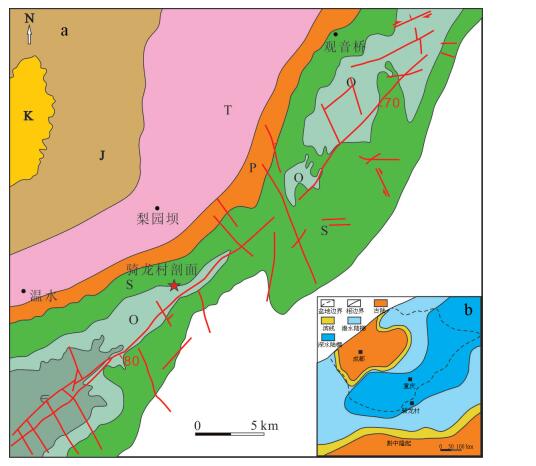
 下载:
下载:
